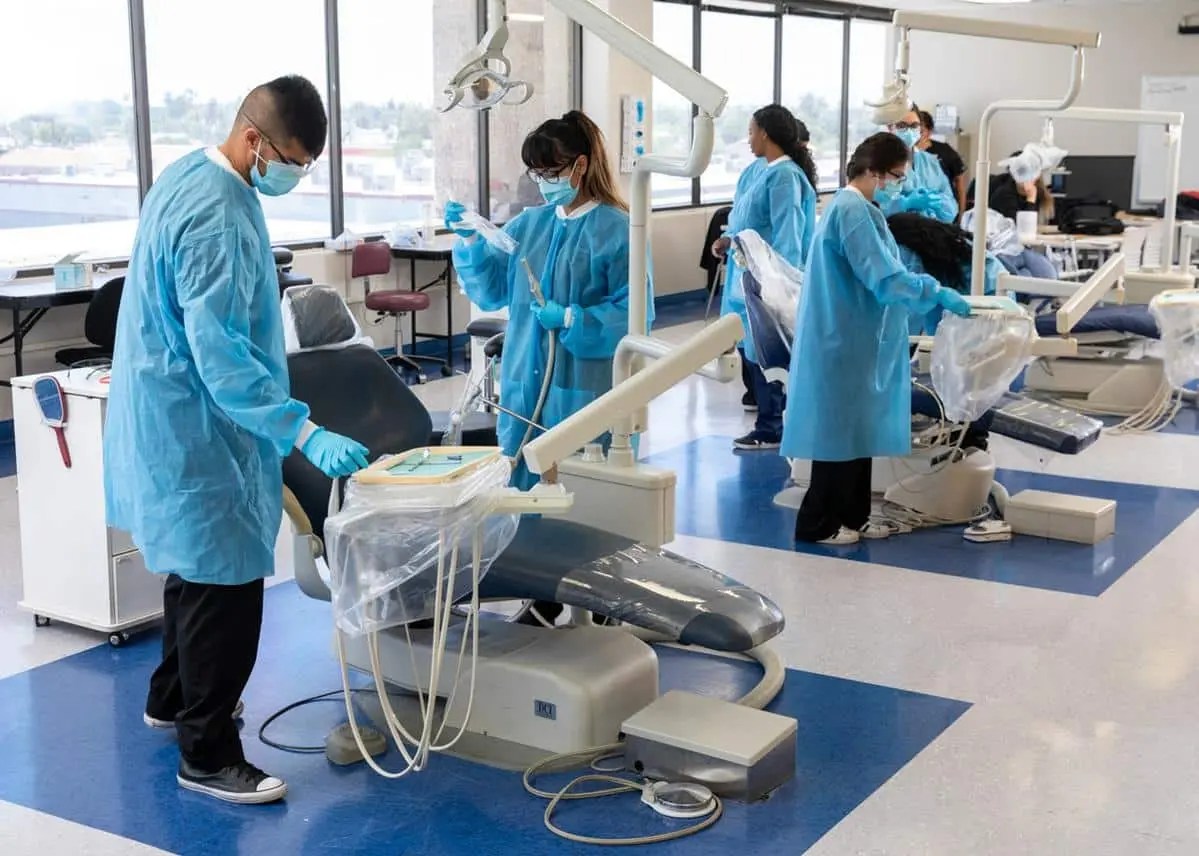Glossary of Terms: Dental Assistant
Classes begin January 12th
Welcome to the fascinating world of Dental Assisting!
Whether you’re considering dental assistant school or already working in the dental assistant field, understanding these terms holds immense benefits. With a strong foundation in these essential concepts, you’ll enhance your professional practice, promote patient safety, and open doors to a rewarding career in dental assisting. So, let’s embark on this educational journey together and explore the numerous advantages that come with mastering some of the featured terms and glossary terms in the dental assistant realm.

General Terms

Tools and Equipment

Common Acronyms
Frequently Asked Questions Relating To A Career In Dental Assisting
Dental assistants often have to manage multiple responsibilities, from patient care to administrative tasks. They may also need to handle difficult patients or work under pressure in busy dental practices.
Career paths and goals can vary greatly depending on the individual. Some dental assistants may aspire to gain more specialized skills, move into office management, or even go back to school to become a dental hygienist or dentist.
Success as a dental assistant often involves strong interpersonal skills, attention to detail, a willingness to continue learning, and a commitment to patient care.
Questions might include asking about the office culture, typical daily responsibilities, opportunities for advancement, and expectations for new hires.
The length of time it takes to become a dental assistant can vary depending on the specific program, but many diploma programs can be completed in less than a year.
Requirements vary by state, but in some cases, it may be possible to become a dental assistant through on-the-job training. However, formal education may lead to more job opportunities and higher pay.
While a degree is not always required, some dental assistants may choose to pursue an associate’s degree. Most dental assistants complete a diploma or certificate program.
General Terms
Caries: The technical term for tooth decay or cavities.
Cosmetic Dentistry: Dental work that improves the appearance of teeth, gums and/or bite.
Dental Anatomy: The field of anatomy dedicated to the study of human tooth structures.
Dental Assistant (DA): A healthcare professional who supports the work of dentists and dental hygienists, usually in a dental office setting. DAs perform both clinical and administrative tasks.
Dental Charting: A process where a dental healthcare professional maps out the inside of a patient’s mouth.
Dental Instruments: Tools that dental professionals use to provide dental treatment.
Dental Prophylaxis: A professional dental cleaning procedure that involves the thorough removal of plaque, calculus, and stains from the teeth.
Dental Prosthesis: An artificial device used to replace one or more missing teeth.
Dental Radiography: The process of taking X-ray images of the teeth and oral structures.
Dental Terminology: The specific language used by dental care professionals for accurate and efficient communication.
Endodontics: The branch of dentistry that deals with diseases of the tooth root, dental pulp, and surrounding tissue.
Fluoride: A natural mineral used to strengthen tooth enamel and prevent decay.
Impression: A mold taken of the teeth and soft tissues for use in preparing dental restorations or orthodontic appliances.
Infection Control: Practices and procedures that prevent the spread of infection, particularly in a healthcare setting.
Oral Hygiene: The practice of keeping the mouth and teeth clean to prevent dental problems.
Orthodontics: The branch of dentistry that corrects teeth and jaws that are positioned improperly.
Patient Privacy (HIPAA): Refers to the Health Insurance Portability and Accountability Act, which provides data privacy and security provisions for safeguarding medical information.
Pedodontics/Pediatric Dentistry: The branch of dentistry dealing with children from birth through adolescence.
Periodontics: The branch of dentistry that deals with diseases of the gum and the structures that support the teeth.
Restorative Dentistry: The management of diseases of the teeth and their supporting structures to rehabilitate the teeth to functional aesthetics.

Dental Assistant Tools and Equipment
Having a solid understanding of these terms is essential for seamless communication, efficient workflow, and the delivery of top-notch patient care. By familiarizing yourself with the terminology surrounding dental instruments, equipment, and materials, you gain the confidence to navigate through various procedures, collaborate effectively with your dental team, and provide exceptional support to both the dentist and the patient. Let’s dive in and explore the vast array of tools and equipment that form the foundation of our profession.
Autoclave: A device that sterilizes dental instruments using high-pressure steam.
Curing Light: A light used to harden light-sensitive resin-based composites.
Dental Burs: The cutting part of the dental drill, they come in a variety of shapes and sizes for different procedures.
Dental Cement Mixer: A device used to mix dental cement used for fillings, crowns, and bridges.
Dental Chair: A chair designed for the patient’s comfort and the dentist’s accessibility during dental procedures.
Dental Drill: A high-speed drill used for many procedures, such as decay removal and shaping tooth structure prior to a filling or crown.
Dental Elevators: Used in the extraction process to loosen teeth.
Dental Explorer (Sickle Probe): A hand tool often used in dental examinations to assess the presence or absence of dental caries.
Dental Forceps: Used for various surgical procedures, including extraction of teeth.
Dental Loupes: Magnifying glasses that dentists wear to enhance vision.
Dental Mirror: A tool used to reflect light and provide indirect vision for easy viewing of patient’s teeth in areas of the mouth where visibility is difficult.
Dental Scaler: A tool used for removing dental plaque and calculus from teeth.
Dental Syringe: A syringe used in dental procedures for the injection of anesthesia.
Dental X-ray Machine: A machine that emits radiation used to capture images of the internal structures of the mouth and jaw.
Impression Trays: Tools used to carry impression material into the mouth when taking a dental impression.
Intraoral Camera: A small video camera that allows the dental professional to view and show the patient a clear picture of the inside of the mouth.
Periodontal Probe: A tool used to measure pocket depths around a tooth in order to establish the state of health of the periodontium.
Saliva Ejector and High-Volume Evacuator (HVE): Tools used to remove saliva, blood, water, and debris from the patient’s mouth during procedures.
Ultrasonic Cleaner: A machine that uses ultrasound to clean dental instruments.

Common Acronyms
As a dental assistant, being fluent in these acronyms is essential for effective communication, streamlined workflows, and maintaining a cohesive dental team. Understanding the terminology behind these abbreviations allows you to navigate through dental charts, treatment plans, and electronic records with ease, ensuring accurate and efficient documentation. By familiarizing yourself with these acronyms, you gain the confidence to communicate effectively with colleagues, stay updated with the latest industry advancements, and provide seamless patient care.
ADA: American Dental Association – The professional organization for dentists in the United States.
AED: Automated External Defibrillator – A portable device that checks the heart rhythm and can send an electric shock to the heart to try to restore a normal rhythm.
BLS: Basic Life Support – A level of medical care which is used for victims of life-threatening illnesses or injuries until they can be given full medical care at a hospital.
CDA: Certified Dental Assistant – A dental assistant who has received certification from an accredited organization, demonstrating a certain level of knowledge and competence.
CDC: Centers for Disease Control and Prevention – The national public health agency of the United States.
CPR: Cardiopulmonary Resuscitation – An emergency procedure that combines chest compressions often with artificial ventilation in an effort to manually preserve intact brain function until further measures are taken to restore spontaneous blood circulation and breathing in a person who is in cardiac arrest.
DA: Dental Assistant – A healthcare professional who supports the work of dentists and dental hygienists, usually in a dental office setting.
HIPAA: Health Insurance Portability and Accountability Act – A US law designed to provide privacy standards to protect patients’ medical records and other health information.
OSAP: Organization for Safety, Asepsis and Prevention – A community of clinicians, educators, researchers, and industry representatives who advocate for safe and infection-free delivery of oral healthcare.
OSHA: Occupational Safety and Health Administration – A federal organization (part of the Department of Labor) that ensures safe and healthy working conditions for Americans by enforcing standards and regulations.
PPE: Personal Protective Equipment – Safety barriers used to protect the skin, clothing, mucous membranes, and airways from infectious agents.
RDA: Registered Dental Assistant – A credential that signifies a dental assistant’s competency and often leads to higher paying job opportunities.
Ready to Pursue a Healthcare Career? Contact Us To Get Started.
Guide to Becoming a Dental Assistant
Ready to make a difference in healthcare? Explore the path to becoming a medical assistant with phlebotomy skills today.








